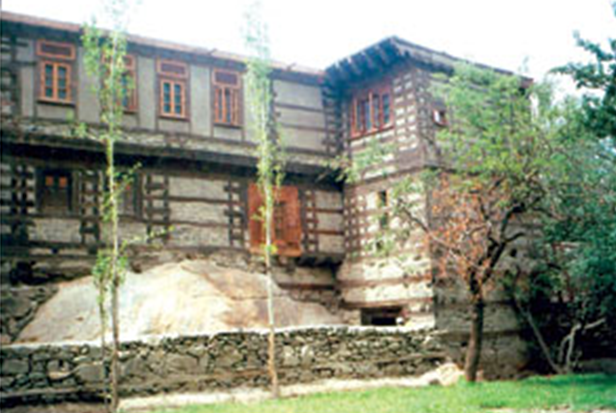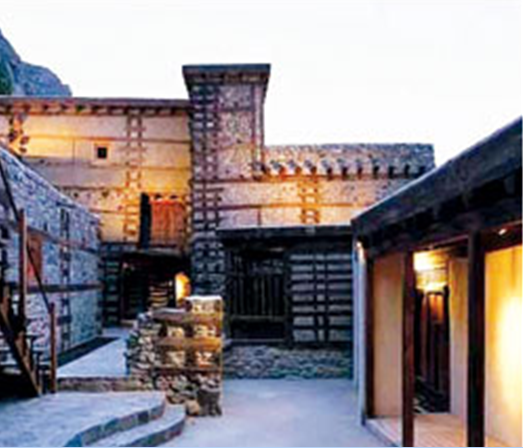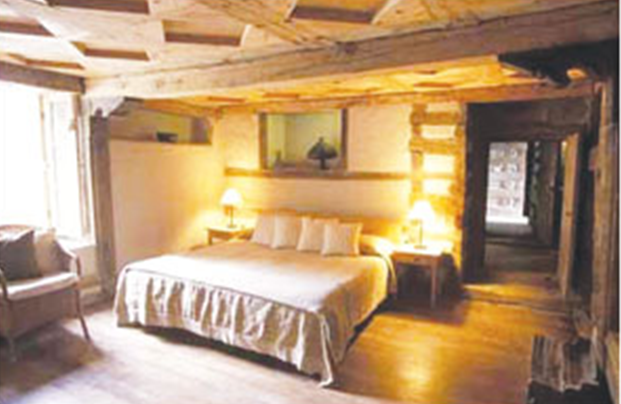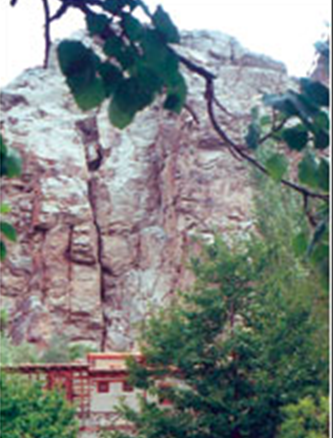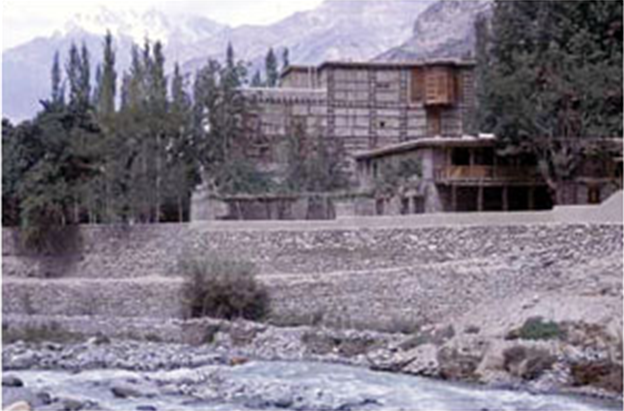Skardu
(Created page with " {| class="wikitable" |- |colspan="0"|<div style="font-size:100%"> This is a collection of articles archived for the excellence of their content.<br/>You can help by convertin...") |
Revision as of 09:51, 24 October 2013
This is a collection of articles archived for the excellence of their content. Readers will be able to edit existing articles and post new articles directly |
Skardu
Salvaging heritage and helping the people
By Rina Saeed Khan
The conversion of the fort into a hotel was painstakingly done so as to remain faithful to its original structure and character. What is surprising is that all this was achieved only in four to five years –– it goes to show what can be done in a short period, given expertise and funding
Skardu, the capital of Baltistan, lies in a wide valley ringed by snow covered peaks and surrounded by a mountain desert. The light, like the landscape, seems softer, more diffused than elsewhere in the Northern Areas. Our destination, however, was Shigar, a picturesque green valley around thirty minutes’ drive away, which lies on the way to the famous Baltoro glacier and K-2.
The settlement of Shigar has been selected by the Aga Khan Trust for Culture (AKTC) for their Historic Cities Support Programme. This programme goes beyond the mere restoration of monuments, and engages in activities related to the adaptive reuse of buildings, directed at improving local living conditions.
In Shigar, the programme has restored the local Raja’s fort palace, converting it into an exclusive guesthouse. This fort palace was crumbling, almost in ruins when the Raja handed it over to the NGO. In return, it built him a rather elegant house close by the hotel, in the style of the traditional architecture of the area but with all the modern amenities.
Unlike other commercial hotels, the ‘Shigar Fort Residence’ ploughs back all its profits into the local community. Already, Shigar valley is benefiting from this project as locals are trained and employed and local handicrafts are sourced for use in the hotel. This up market hotel is already attracting international tourists to this culturally rich region, which is also home to some of the highest mountains on earth.
In 2006, Aga Khan finally inaugurated the Shigar Fort hotel, although it has been operating now since 2005. In September, 2006, the Unesco Regional Advisor for Culture in Asia and the Pacific announced that Shigar Fort has been honoured with the Award of Excellence for Culture Heritage Conservation. The Norwegian government was the main partner in the restoration of the fort. Funding was also provided by the governments of Germany, Greece, Japan, Pakistan, Spain and Switzerland.
Baltistan is often called ‘Little Tibet’ and its architecture reflects the area’s historic links with that region. In fact, Baltistan lies at the junction of the Islamic and Buddhist worlds and its inhabitants were mostly Buddhist before converting to Islam. One can find the remains of old monasteries on the ridges and the wooden carvings on the doors and pillars use Buddhist motifs like the lotus flower. Shigar Fort has plenty of these motifs on its carved beams and doorways.
Shigar is a lush green valley located near the river’s edge. It was ruled for centuries by the Amacha dynasty, which had its origins in the Hamacha tribe of Hunza. Some believe that a young man from Hunza with the name of Amacha came to Shigar using a passage across the Hispar glacier. Other writers think that as the Hamacha tribe was massacred in Hunza, some members managed to flee to Shigar where they gained power and won recognition as the Amacha in the 13-14th centuries.
Raja Hassan Khan ascended the throne in 1634, and with the permission of the Mughal emperor Shah Jehan, brought various artisans including shawl weavers, carpenters, goldsmiths and stone-carvers from Kashmir to Shigar.
He built Shigar Fort upon a huge boulder and it is known locally as Fongkha ––– literally, ‘the palace on the rock’. The rock is the first thing most visitors notice upon arrival at the fort: the large boulder protrudes obtrusively from the walls at the entrance.
The fort itself was designed as a cribbage structure with interlacing wooden beams (which protects the structure from earthquakes). Its three stories are built on a massive platform using the rock as its foundation. Walking around the well-kept garden and gazing up at its newly renovated stone walls with their crisscrossing wooden beams, one could hardly believe that it had all been in complete shambles when the present Raja, Mohammad Ali Shah, gifted it to the NGO back in 1999.
Indeed, the fort had been in a dilapidated condition for a very long time. The Raja had abandoned it back in the 1950s in favour of an annexe he built for himself nearby. Today these have been turned into a kitchen and dining room. The Raja has also leased his large garden and orchard to the AKTC and they have built some more guestrooms around it.
The restoration has led to a revitalisation of the surrounding villages, where the NGO has helped to install proper sanitation and clean drinking water. In the years to come the fort will generate the necessary funds for its future maintenance and for supporting community projects
“This was a completely feudal society and the Raja’s rule was absolute. Today, of course, there are no more fiefdoms in the Northern Areas (since the mid-1970s) and the people are adjusting to this change,” says Safiullah Baig, the deputy manager of the AKCSP.
“Yet, the forts and palaces are all part of the people’s heritage, their identity and we want the local people to take pride in them and feel a sense of ownership. In Hunza, the local people now refer to the Baltit Fort museum, which once belonged to the Mir, as ‘our fort’. When we completed Shigar Fort’s restoration, the Raja asked us ‘if you don’t mind, could I have a look around’? This was his home, where he grew up and yet he is comfortable with the change.” All the young architects and designers who worked on the fort are also from the Northern Areas and have been given special training by the AKTC.
The fort’s garden overlooks a rushing stream and most of the rooms on one side have views of this picturesque scene. Inside the newly renovated fort, spotlights illuminate the reception area which is located on the first floor. It is quite gloomy inside, although some natural light filters in through a small window in the thick walls. There is a museum here, in the oldest part of the fort. A smattering of antiques ––– old utensils, wooden containers and carved pillars are displayed in a tasteful manner.
The terrace outside the first floor leads to the newly renovated bedrooms. A peak inside revealed an elegant room with a comfortable bed, small desk, stylish lamps and rolled up blinds on the small windows. In the walls were recesses displaying antiques. A small bathroom with modern amenities is attached to each bedroom. It is really amazing that people can enjoy the 21st century luxury in a 17th century fort!
There are thirteen rooms in the fort and each is different. They are of varying sizes; some have bed niches, others have screens or woodcarvings. Yet they are all comfortable and inviting, with soft hand-woven textiles, wooden floors and lime washed walls. The architects have tried to retain as much as possible of the fort’s authentic character.
Modern furniture is minimal -–– the focus is on the spectacular woodwork and the artefacts of the region which have been placed sparingly in each room. They say that good design is what you leave out, and it is obvious that the designers have put a lot of thought into each room.
Many hours of meticulous planning and attention to detail have gone into each room. “We have used local materials and handicrafts,” explained Shehnaz Ismail, who is in charge of the textiles, crockery, and the discreet interiors of the hotel. “The idea is to be faithful to the culture of this region. This is not a luxurious hotel ––– it is really for discerning clients who are looking for authenticity.”
Ismail has initiated a project in which locals from the community are taught new designs and asked to weave woollen rugs. She hopes to revive traditional skills ––– the handicrafts can be bought by tourists as souvenirs.
“This project is unique in Pakistan. It was done in a relatively fragile building fabric,” explained Masood Khan, one of the leading architects of the project. “We had to be very careful and make sure the installations are as reversible as possible. We did not want the modern additions to invade the fabric of the building.”
Guests staying at Shigar Fort are expected to treat the fort with the kind of respect and loving care that the staff accords to it. Thus, for instance, eating in the bedrooms is strictly forbidden.
The conversion of the fort into a hotel was painstakingly done so as to remain faithful to its original structure and character. What is surprising is that all this was achieved only in four to five years -––– it goes to show what can be done in a short period, given expertise and funding and the will to work.
Already, the restoration has led to a revitalisation of the surrounding villages, where the NGO has helped to install proper sanitation and clean drinking water. In the years to come the fort will generate the necessary funds for its future maintenance and for supporting community projects. This project could really become a model for the renovation of dilapidated forts and palaces not only in the Northern Areas, but all over Pakistan.
HCSP Historic Cities Support Programme Baltit etc Historic Cities Support Programme The HCSP was established by the Aga Khan Development Network in 1992. It undertakes the conservation and rehabilitation of historical buildings and urban spaces in ways that serve to catalyse social, economic and cultural development. Since its inception, over twenty distinct projects have been initiated in several different regions of the Islamic world.
In Kabul, the HCSP is leading a project to rehabilitate the Babur Garden, the oldest Mughal 'Paradise garden', which contains the tomb of 16th century emperor Babur. In the Northern Areas of Pakistan, projects for the rehabilitation and reuse of historic forts, landmark buildings and traditional settlements, as well as the promotion of traditional crafts and building techniques, have helped transform poor communities into relatively prosperous ones. In 2004, the Baltit Fort restoration project in Hunza received the UNESCO award for excellence.
The restored Baltit Fort, now a museum, attracts over 20,000 visitors annually, half of which are from outside the country. –– R.S.K
